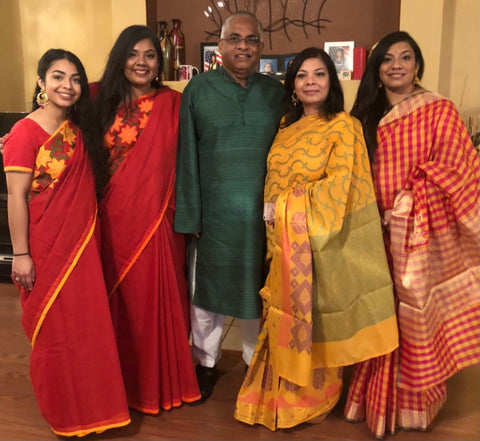The Origins of Bangla Language
Adiya Rahman, Waco TX, USA
One of my fondest memories growing up—and probably one that most first generation American kids can relate to—is the memory of being forced to talk on the phone to all of my relatives in Bangladesh.

Photo courtesy of Adiya Rahman
My parents would tell us that my Nanu and Dadu didn’t know English, so I had to speak in Bangla only. I remember the apprehension before the phone was handed to me, and always leaving the room so that my parents wouldn’t poke fun at my broken Bangla. Short conversations riddled with “ji’s and “na’s” have slowly become my favorite experiences that I’m so grateful to have had as they were the foundation of me knowing my parents’ beautiful mother tongue of Bangla.
"With my sister Aliza, when we were little and learning to converse in broken Bangla with relatives in Bangladesh" (pc: Adiya Rahman)
The Bengali language, or Bangla, has developed over the course of 1300 years, becoming the seventh most spoken language in the world today. During ancient and early eras, dating all the way back to the first millennium BCE, the Bengali language was derived from Sanskrit, and particular dialects known as Magadhi Prakrit, which influenced the languages of modern-day Bihar and Assam as well as Bangla. During medieval times, the language faced much Islamic influence with the rise of migratory movements of Arab Muslims and Turco-Persians in the region. Bangla later became the official court language under the Sultans of Bengal, which served to cultivate Islamic culture in the language itself. Moreover, much like the people and culture it represents, modern-day Bangla is deeply rooted in history and represents a mosaic of cultures and languages across Asia with influences from Middle Into-Aryan Languages, Sanskrit, Persian, Arabic, and other Austroastiatic languages.
Bangla Bhasha (iStock)
In 1948, the Government of Pakistan attempted to impose Urdu as the sole language across the state of Pakistan. This initiated the Bengali Language Movement in which citizens across the Bengali speaking majority of East Bengal advocated for the recognition of Bangla, both spoken and written, as an official language of the Dominion of Pakistan and for its inclusion in government affairs, education, media and arts, and more. This led to a rise in tensions and sparked protests across the region for several years. The movement came to a head when the government of Pakistan maintained that only Urdu would be recognized as the official language of Pakistan. In response, on February 21, 1952, students of the University of Dhaka as well as other political activists unlawfully organized and participated in a protest in which protestors gathered defiantly in a face-off with armed police.
The morning of 21 February 1952, students began gathering on the premises of the University of Dhaka in defiance of Section 144 of the penal code (commons photo)
This demonstration led to the death of several students and activists by the police. The deaths further provoked widespread civil unrest against the oppression of the Pakistani leadership, and after several years of conflict, the Bangla language was finally granted official status by the central government in 1956. Since then, the 21st of February (Ekushey February) has been celebrated as a national holiday in Bangladesh commemorating the movement and the lives that were lost. In 1999, UNESCO declared the 21st of February as International Mother Language Day as a tribute to the Language Movement of Bangladesh and in recognition of the cultural and linguistic rights of people all over the world.
The Shaheed Minar monument in Dhaka, Bangladesh commemorates the lives lost during the Bengali Language Movement prior to Bangladeshi independence (commons photo)
As I reflect on my experiences living in the States, I am beyond grateful to have parents, grandparents, aunts, and uncles who have taught me their language. A language that was literally fought for so that, generations later, people like me could continue to experience and share its love and beauty across the globe. I think about the generations after me and can’t help but chuckle at the thought of my future kids, nieces, and nephews reluctant about having to speak on the phone with their aunts and grandparents who “only speak Bangla.”
Family (pc: Adiya Rahman)
Adiya Rahman is a first generation Bangladeshi-American pre-med student majoring in neuroscience at Baylor University in Waco, Texas.






